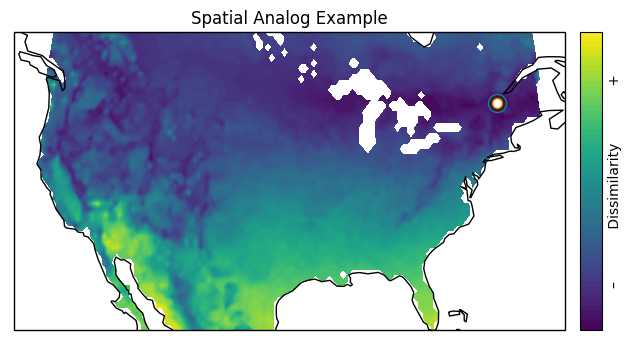Advanced climate data analysis¶
Spatial analogues¶
Spatial analogues are maps showing which areas have a present-day climate that is analogous to the future climate of a given place. This type of map can be useful for climate adaptation to see how well regions are coping today under specific climate conditions. For example, officials from a city located in a temperate region that may be expecting more heatwaves in the future can learn from the experience of another city where heatwaves are a common occurrence, leading to more proactive intervention plans to better deal with new climate conditions.
Spatial analogues are estimated by comparing the distribution of climate indices computed at the target location over the future period with the distribution of the same climate indices computed over a reference period for multiple candidate regions. A number of methodological choices thus enter the computation:
- Climate indices of interest,
- Metrics measuring the difference between both distributions,
- Reference data from which to compute the base indices,
- A future climate scenario to compute the target indices.
The climate indices chosen to compute the spatial analogues are usually annual values of indices relevant to the intended audience of these maps. For example, in the case of the wine grape industry, the climate indices examined could include the length of the frost-free season, growing degree-days, annual winter minimum temperature andand annual number of very cold days [Roy2017].
The flyingpigeon.processes.SpatialAnalogProcess offers six
distance metrics: standard euclidean distance, nearest neighbor,
Zech-Aslan energy distance, Kolmogorov-Smirnov statistic,Friedman-Rafsky runs
statistics and the Kullback-Leibler divergence. A description and reference for
each distance metric is given in flyingpigeon.dissimilarity and based
on [Grenier2013].
The reference data set should cover the target site in order to perform validation tests, and a large area around it. Global or continental scale datasets are generally used, but the spatial resolution should be high enough for users to be able to recognize climate features they are familiar with.
Different future climate scenarios from climate models can be used to compute the target distribution over the future period. Usually the raw model outputs are bias-corrected with the observation dataset. This is done to avoid discrepancies that would be introduced by systematic model errors. One way to validate the results is to compute the spatial analog using the simulation over the historical period. The best analog region should thus cover the target site.
The WPS process automatically extracts the target series from a netCDF file using geographical coordinates and the names of the climate indices (the name of the climate indices should be the same for both netCDF files). It also allows users to specify the period over which the distributions should be compared, for both the target and candidate datasets.
An accompanying process flyingpigeon.processes.MapSpatialAnalogProcess
can then be called to create a graphic displaying the dissimilarity value.
An example of such graphic is shown below, with the target location indicated
by a white marker.

A map of the dissimilarity metric computed from mean annual precipitation and temperature values in Montreal over the period 1970-1990.
-
class
flyingpigeon.processes.SpatialAnalogProcess[source]¶ spatial_analog Spatial analog of a target climate. (v0.1)
Spatial analogs based on the comparison of climate indices. The algorithm compares the distribution of the target indices with the distribution of spatially distributed candidate indices and returns a value measuring the dissimilarity between both distributions over the candidate grid.
Parameters: - candidate (application/x-netcdf, application/x-tar, application/zip) – NetCDF files or archive (tar/zip) storing the candidate indices. The output will be stored on this grid. (Info)
- target (application/x-netcdf, application/x-tar, application/zip) –
NetCDF files or archive (tar/zip).containing netcdf files storing the target indices. (Info)
- location (string) – Geographical coordinates (lon,lat) of the target location.
- indices (string) – One or more climate indices to use for the comparison.
- dist ({'seuclidean', 'nearest_neighbor', 'zech_aslan', 'kolmogorov_smirnov', 'friedman_rafsky', 'kldiv'}, optional) – Dissimilarity metric comparing distributions.
- dateStartCandidate (string, optional) – Beginning of period (YYYY-MM-DD) for candidate data. Defaults to first entry.
- dateEndCandidate (string, optional) – End of period (YYYY-MM_DD) for candidate data. Defaults to last entry.
- dateStartTarget (string, optional) – Beginning of period (YYYY-MM-DD) for target data. Defaults to first entry.
- dateEndTarget (string, optional) – End of period (YYYY-MM_DD) for target data. Defaults to last entry.
Returns: - output_netcdf (application/x-netcdf) – Dissimilarity between target at selected location and candidate distributions over the entire grid.
- output_log (text/plain) – Collected logs during process run.
References
-
class
flyingpigeon.processes.MapSpatialAnalogProcess[source] map_spatial_analog Map of dissimilarity values calculated by the spatial_analog process. (v0.1)
Produce map showing the dissimilarity values computed by the spatial_analog process as well as indicating by a marker the location of the target site.
Parameters: - resource (application/x-netcdf, application/x-tar, application/zip) –
Dissimilarity between target at selected location and candidate distributions over the entire grid. (Info)
- fmt ({'png', 'pdf', 'svg', 'ps', 'eps'}, optional) – Figure format
- title (string, optional) – Figure title.
Returns: - output_figure (image/png, application/pdf, image/svg+xml, application/postscript) – Map of dissimilarity values.
- output_log (text/plain) – Collected logs during process run.
References
- resource (application/x-netcdf, application/x-tar, application/zip) –
References
| [Roy2017] | Roy, P., Grenier, P., Barriault, E. et al. Climatic Change (2017) 143: 43. doi:10.1007/s10584-017-1960-x |
| [Grenier2013] | Grenier, P., A.-C. Parent, D. Huard, F. Anctil, and D. Chaumont, 2013: An assessment of six dissimilarity metrics for climate analogs. J. Appl. Meteor. Climatol., 52, 733–752, doi:10.1175/JAMC-D-12-0170.1 |